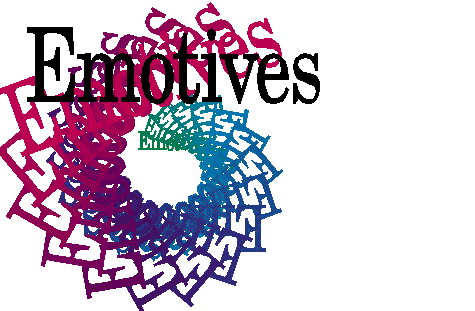


Text is a subjective experience. Words on a page or on a screen are always victims of interpretations, often not entirely in the spirit with which the author intended them. So, on the Internet, an environment where interpretation is everything, a system of inflection has evolved to aid writers. This system includes facial expressions made out of punctuation marks, asterisks and underscores as emphasis, and asterisks and hyphens to denote action. Inflection on the Internet may seem rather complex at first, but it is really on as complex as the writer himself makes it.
Emotives and emoticons are the symbols and words which represent the actions and emotions of the writer in text. Emotives have become integral to many users' e-mail communications. Some users don't even consciously think any more before tagging a ";)" onto the end of a joke or a "=)" in response to a surprising statement.

Smileys are an integral part of textual inflection for those who use them. A smiley can say so much with so few characters and serve as facial expressions in textual conversations. An amazing 66% of participants in the Blitzmail questionnaire stated that they used smileys on a regular basis. By far this was the favorite emote used by Dartmouth users participating in the survey. Smileys are easy to use and in their simpler forms, fairly representative of the human facial impression they attempt to imitate. The most basic smiley is:
:-)
This is just a happy face, not too much explanation is involved. A student even commented that often he will just send a smiley to a friend in a blitz just to cheer someone up.
;-) is a wink. This emotive is particularly useful for those who like to be coy or make jokingly sarcastic comments over e-mail. A wink inserted at the end of a viscously sarcastic or flaming message will inflect an air of fun and help to insure that the reader is not taking the message too seriously.
:-P is someone sticking their tongue out, either in disgust or in a teasing way. As you can imagine, smileys come in handy for any number of things you want to say but just can't put into the proper words as well as coming in handy to help the reader understand your tone of voice, so to speak.
With such a fun topic, it's not surprising that people are compiling smileys and inventing new ones all the time. Some are even making money off the venture! Below is a short list links to compilations of smiley faces. Some lists are more extensive than others, but there is a lot of overlap among them. Universal smiley faces exist, such as the three I described above, and are widely recognized on the Internet.

Lexicons of Smilies on the Internet:

Of course, if you can smile in text you should be able to emote your body language as well. The device for performing action on the Internet is largely the asterisk (or rather a pair of asterisks, and, to a much lesser extent, hyphens). These marks serve to set off actions such as sighing or laughing from the rest of the text so that the reader realizes that there is action implied. Only 37% of the respondents indicated a use of asterisks, however that is still significant since it is well over a third of the parties participating. Some common action-emotes to see are:

Writers have dozens and dozens of techniques for emphasizing their words. Similarly, electronic communications users have many ways to emphasize their words. There are, however, two primary ways of emphasizing words in text: asterisks and underscores. This time the asterisk is used to set off text or a word the writer particularly wants noticed. Underscores are used in much the same way but are also found to be synonymous with underlining. Since there are so many different electronic mail systems running on different kinds of computer systems, a lot of special formatting is simply not supported by the mail systems. So, users get innovative.

| TOC | Intro | Tone | Dartmouth | Grammar | Emotives | Acronyms | Quotes | Conclusion | Contributors | Bibliography |
Last modified by Carla C. Emmons 10 March 1996.